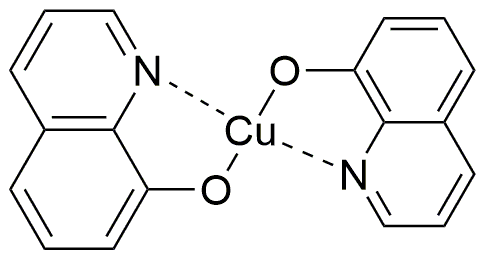Bis(8-quinolinolato)copper(II) is widely utilized in research focused on:
- Coordination Chemistry: This compound serves as a model for studying metal-ligand interactions, helping researchers understand the behavior of transition metals in various environments.
- Antimicrobial Applications: It has shown potential as an antimicrobial agent, making it valuable in the development of new treatments for infections, particularly in the pharmaceutical industry.
- Electrochemical Sensors: Its unique properties allow it to be used in the creation of sensitive electrochemical sensors for detecting environmental pollutants and toxins, benefiting environmental monitoring efforts.
- Organic Light Emitting Diodes (OLEDs): The compound is explored for its role in OLED technology, contributing to advancements in energy-efficient lighting and display technologies.
- Biological Imaging: Researchers utilize it in biological imaging applications, where its fluorescence properties aid in visualizing cellular processes, enhancing our understanding of biological systems.
General Information
Properties
Safety and Regulations
Applications
Bis(8-quinolinolato)copper(II) is widely utilized in research focused on:
- Coordination Chemistry: This compound serves as a model for studying metal-ligand interactions, helping researchers understand the behavior of transition metals in various environments.
- Antimicrobial Applications: It has shown potential as an antimicrobial agent, making it valuable in the development of new treatments for infections, particularly in the pharmaceutical industry.
- Electrochemical Sensors: Its unique properties allow it to be used in the creation of sensitive electrochemical sensors for detecting environmental pollutants and toxins, benefiting environmental monitoring efforts.
- Organic Light Emitting Diodes (OLEDs): The compound is explored for its role in OLED technology, contributing to advancements in energy-efficient lighting and display technologies.
- Biological Imaging: Researchers utilize it in biological imaging applications, where its fluorescence properties aid in visualizing cellular processes, enhancing our understanding of biological systems.
Documents
Safety Data Sheets (SDS)
The SDS provides comprehensive safety information on handling, storage, and disposal of the product.
Product Specification (PS)
The PS provides a comprehensive breakdown of the product’s properties, including chemical composition, physical state, purity, and storage requirements. It also details acceptable quality ranges and the product's intended applications.
Certificates of Analysis (COA)
Search for Certificates of Analysis (COA) by entering the products Lot Number. Lot and Batch Numbers can be found on a product’s label following the words ‘Lot’ or ‘Batch’.
*Catalog Number
*Lot Number
Certificates Of Origin (COO)
This COO confirms the country where the product was manufactured, and also details the materials and components used in it and whether it is derived from natural, synthetic, or other specific sources. This certificate may be required for customs, trade, and regulatory compliance.
*Catalog Number
*Lot Number
Safety Data Sheets (SDS)
The SDS provides comprehensive safety information on handling, storage, and disposal of the product.
DownloadProduct Specification (PS)
The PS provides a comprehensive breakdown of the product’s properties, including chemical composition, physical state, purity, and storage requirements. It also details acceptable quality ranges and the product's intended applications.
DownloadCertificates of Analysis (COA)
Search for Certificates of Analysis (COA) by entering the products Lot Number. Lot and Batch Numbers can be found on a product’s label following the words ‘Lot’ or ‘Batch’.
*Catalog Number
*Lot Number
Certificates Of Origin (COO)
This COO confirms the country where the product was manufactured, and also details the materials and components used in it and whether it is derived from natural, synthetic, or other specific sources. This certificate may be required for customs, trade, and regulatory compliance.


